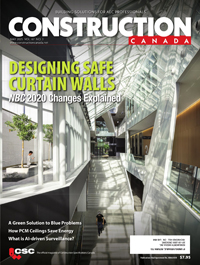Designing with natural stone cladding

Backup selection
The types of backup used by the building designer can, in many cases, determine the success or failure of a cladding project.
Concrete
Concrete tends to be the preferred backup for exterior and interior cladding. Anchors can be placed anywhere, allowing the stone designer the flexibility to design an efficient, installer-friendly anchoring system. Anchor capacities are typically highest when installed into concrete.
Masonry
When used for interior cladding where panels are stacked, concrete masonry units (CMUs) can comprise a very suitable backup assembly. If used for exterior cladding (i.e. where anchors are designed to support the weight of each panel), the CMUs must be solid-filled with masonry grout to ensure anchors can achieve the required capacity.
If masonry is not properly filled, positive anchorage is very difficult to achieve and may require the use of adhesive or epoxy anchors. These anchors are more costly and require time to set up, particularly when ambient temperatures are low.
Steel sub-frames
When designed by the stone installer’s engineer, steel sub-frames can be a very effective and economical backup. However, if the frames are not designed to accommodate the stone designer’s anchors, they can be ineffective and very often require either additional steel, or for the stone designer to engineer an expensive anchoring system to suit the steel provided.
Pre-panelized sub-frames
Pre-panelized sub-frames can also be an effective installation method, allowing much of the installation to take place in a shop protected from the elements. However, this method of installation requires close co-ordination with the architect and prime engineer on the project.
Metal stud
When used for interior cladding where panels are stacked, metal studs serve as an acceptable backup. When used for exterior cladding, however, it is the least preferred. This is because the capacity of anchors into metal studs is limited. The placement of the studs is critical and usually does not align with the stone connections. Consequently, use of a continuous horizontal formed channel along each horizontal joint to facilitate the stone anchors is required.
There is also some concern with the service life of the anchorage into metal studs, given the drilled anchor must cut through the metal stud—possibly compromising its corrosion resistance at the anchor. This results in the stone having a much longer service life than the anchors.







